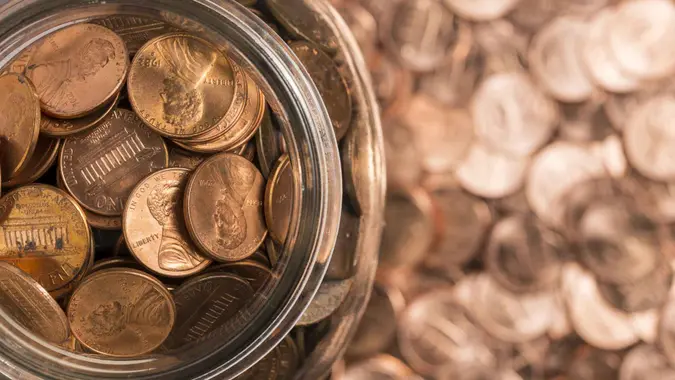These 4 Items Are in Short Supply — What It Means for Your Wallet

Commitment to Our Readers
GOBankingRates' editorial team is committed to bringing you unbiased reviews and information. We use data-driven methodologies to evaluate financial products and services - our reviews and ratings are not influenced by advertisers. You can read more about our editorial guidelines and our products and services review methodology.

20 Years
Helping You Live Richer

Reviewed
by Experts

Trusted by
Millions of Readers
Vova Even’s livelihood depends on his intimate knowledge of supply chains and product availability — and he’s noticed that some major warning signs are flashing bright red.
According to Even, a consumer trends analyst, shopping expert and founder of a self-titled e-commerce education website and YouTube channel, “Lately, the buzz around product shortages has been hard to ignore. Having been in the trenches of e-commerce and observing consumer patterns, I’ve seen some of our favorite products taking a hit in supply.”
He continued, “These examples are just the tip of the iceberg, but they underscore just how interconnected our world is and how a snag in one corner can ripple out to your shopping list.”
Rice
Rice is arguably the world’s most important agricultural commodity. The primary food staple for more than half the world’s population, it accounts for nearly one in five calories consumed worldwide — and it’s currently in dangerously short supply.
“For all you sushi aficionados, the news isn’t great,” said Even. “A mix of bad weather in places like China and Pakistan added to the political rumblings in areas like Ukraine, has shaken up the rice market. And with India hitting pause on non-basmati white rice exports, those price tags are creeping up.”
According to the AP, the rice shortage — which has roots in Africa as well as India — equals 9.5 million metric tons, roughly one-fifth of global exports.
What It Means for Your Wallet
In August, NPR reported that the price of rice had risen by 20% since June and closed out the summer at a 12-year high.
Tequila
Most spirits are made from fermented grains like corn, wheat, barley and rye. But the source of tequila’s infamous kick is a plant that takes years to reach maturity — and its tight supply is struggling to keep up with fast-rising demand.
“For those who enjoy unwinding with a margarita, there’s a hiccup on the horizon,” said Even. “Agave, the heart of tequila, takes its sweet time to grow — almost a decade.”
Supply Management projects the tequila market will rise by a whopping 88% by 2026, an unsustainable level of growth considering the plant’s sluggish biological timeline.
“Throw in hurdles like fewer hands on the farm, changing weather patterns and packaging woes, and well, your tequila might be a tad harder to come by,” said Even.
What It Means for Your Wallet
According to Men’s Journal, “all brands of tequila, high-end and low” are increasing in price by $2-$3 every two months.
Champagne
If you can’t afford Tequila, don’t expect to find much relief in the bubbly section of the liquor store. According to Robb Report and Wine Enthusiast, America is in the early stages of a champagne shortage that is expected to last through at least 2025.
“If you had grand plans for a champagne toast, you might want to hold that thought,” said Even. “The bubbles are facing their own set of challenges. From misjudging the thirst for champagne to a global glass shortage and less-than-ideal weather, the champagne aisles might look a tad emptier.”
Other primary challenges include leftover COVID-era supply chain issues, freight backlogs, high production costs, the product’s significant time and material requirements and a climate-induced crop failure in 2021.
What It Means for Your Wallet
According to Luxury Tribune, the cost of champagne in the United States rose by 11% in 2023, dramatically outpacing inflation and even the fast-rising price of spirits.
Chile Peppers and the Sriracha They Make
Red jalapenos are a type of chili pepper that gives America’s favorite hot sauce its trademark citrusy-sweet but spicy flavor profile. Unfortunately for those who like it hot, they’re grown in a part of Mexico that’s been ravaged by drought, making the already expensive commodity — which is painstakingly picked by hand — painfully hard to come by.
“That fiery kick from chili peppers might become a luxury,” said Even. “Unpredictable weather has thrown a wrench in the harvest in places like northern Mexico. On top of that, the folks at Huy Fong Foods, the brains behind that iconic sriracha sauce, are juggling with a tangled supply chain. Don’t be surprised if that fiery red bottle starts playing hard to get at your local supermarket.”
What It Means for Your Wallet
Sriracha has become prohibitively expensive in much of the country — if you can even find it. According to The Atlantic, supermarkets have set per-customer purchasing limits and bottles are going for $50 or more on sites like Amazon, Craigslist and eBay.
More From GOBankingRates
 Written by
Written by  Edited by
Edited by 

























